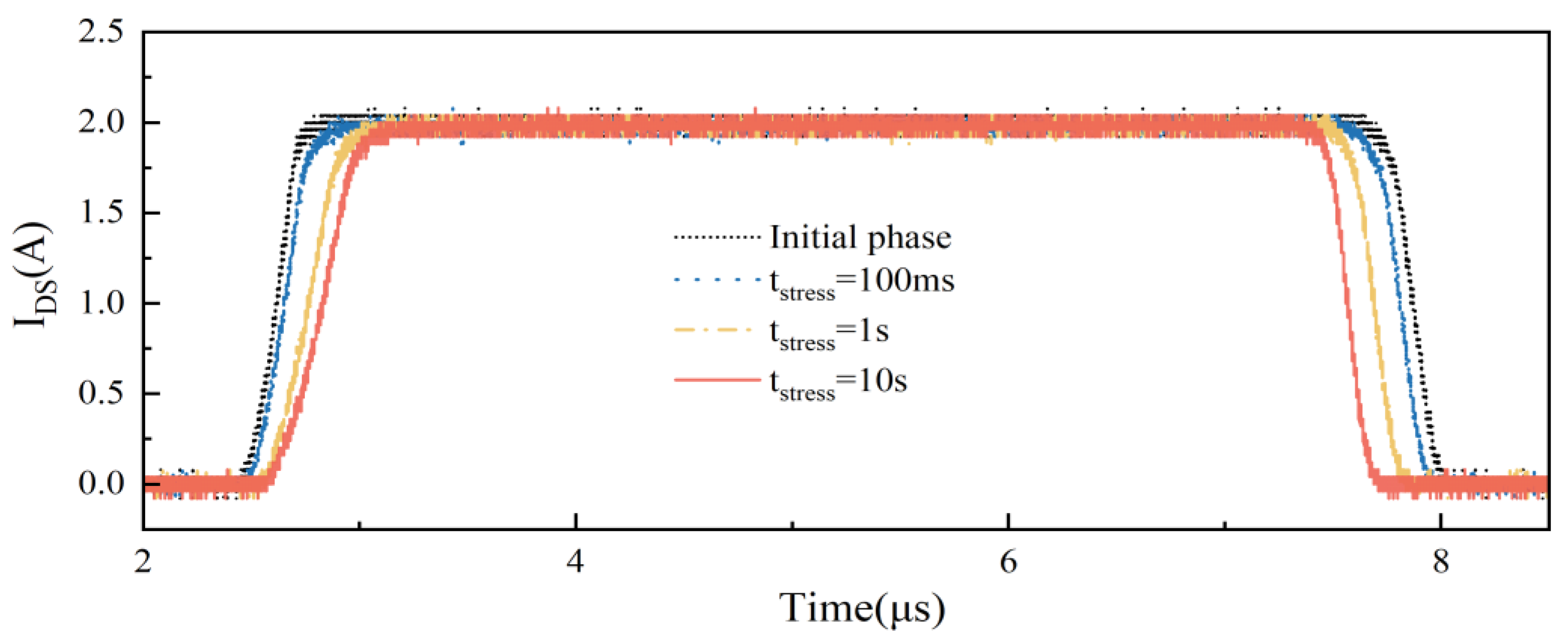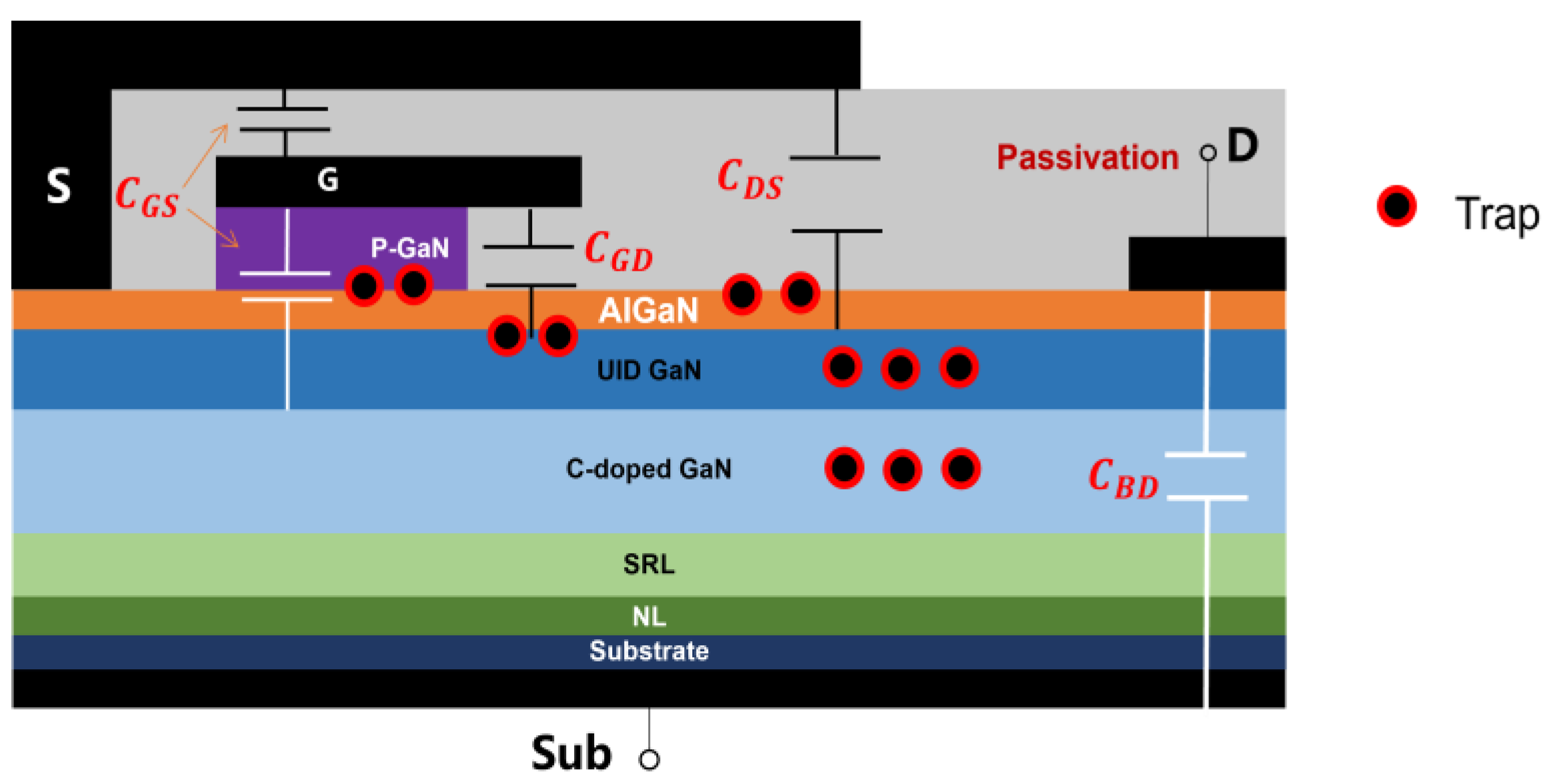A Study on the Dynamic Switching Characteristics of p-GaN HEMT Power Devices
Abstract
1. Introduction
2. Dynamic Switch Test of GaN Device
3. Experimental Results and Analysis
3.1. Experimental Results
3.2. Mechanism Analysis
4. Conclusions
Author Contributions
Funding
Data Availability Statement
Acknowledgments
Conflicts of Interest
References
- Sun, R.; Lai, J.; Chen, W.; Zhang, B. GaN Power Integration for High Frequency and High Efficiency Power Applications: A Review. IEEE Access 2020, 8, 15529–15542. [Google Scholar] [CrossRef]
- Gupta, S.D.; Joshi, V.; Chaudhuri, R.R.; Shrivastava, M. Part I: Physical Insights Into Dynamic RON Behavior and a Unique Time-Dependent Critical Stress Voltage in AlGaN/GaN HEMTs. IEEE Trans. Electron Dev. 2021, 68, 5720–5727. [Google Scholar] [CrossRef]
- Zhang, H.; Kang, X.; Zheng, Y.; Wu, H.; Wei, K.; Liu, X.; Ye, T.; Jin, Z. Investigation on Dynamic Characteristics of AlGaN/GaN Lateral Schottky Barrier Diode. Micromachines 2021, 12, 1296. [Google Scholar] [CrossRef] [PubMed]
- Mortazavizadeh, S.A.; Palazzo, S.; Amendola, A.; De Santis, E.; Di Ruzza, D.; Panariello, G.; Sanseverino, A.; Velardi, F.; Busatto, G. High Frequency, High Efficiency, and High Power Density GaN-Based LLC Resonant Converter: State-of-the-Art and Perspectives. Appl. Sci. 2021, 11, 11350. [Google Scholar] [CrossRef]
- Ekhtiari, M.; Andersen, T.; Andersen, M.A.E.; Zhang, Z. Dynamic Optimum Dead Time in Piezoelectric Transformer-Based Switch-Mode Power Supplies. IEEE Trans. Power Electron. 2017, 32, 783–793. [Google Scholar] [CrossRef][Green Version]
- Modolo, N.; Tang, S.-W.; Jiang, H.-J.; De Santi, C.; Meneghini, M.; Wu, T.-L. A Novel Physics-Based Approach to Analyze and Model E-Mode p-GaN Power HEMTs. IEEE Trans. Electron Dev. 2021, 68, 1489–1494. [Google Scholar] [CrossRef]
- Abdulsalam, A.; Karumuri, N.; Dutta, G. Modeling and Analysis of Normally-OFF p-GaN Gate AlGaN/GaN HEMT as an ON-Chip Capacitor. IEEE Trans. Electron Dev. 2020, 67, 3536–3540. [Google Scholar] [CrossRef]
- Zhang, H.; Kang, X.; Zheng, Y.; Wei, K.; Wu, H.; Liu, X.; Ye, T.; Jin, Z. Investigation on Capacitance Collapse Induced by Secondary Capture of Acceptor Traps in AlGaN/GaN Lateral Schottky Barrier Diode. Micromachines 2022, 13, 748. [Google Scholar] [CrossRef] [PubMed]
- Lee, I.; Yoon, D.; Cho, Y. Correction: Estimation of Switching Losses Considering Non-Linear Parasitic Capacitances of GaN E-HEMT. J. Power Electron. 2023, 23, 1447. [Google Scholar] [CrossRef]
- Aamir Ahsan, S.; Ghosh, S.; Sharma, K.; Dasgupta, A.; Khandelwal, S.; Chauhan, Y.S. Capacitance Modeling in Dual Field-Plate Power GaN HEMT for Accurate Switching Behavior. IEEE Trans. Electron Dev. 2016, 63, 565–572. [Google Scholar] [CrossRef]
- Hwang, I.; Lee, M.-J.; Bae, J.; Hong, S.; Kim, J.-S.; Choi, J.; Deng, X.L.; Ahn, S.-E.; Kang, S.-O.; Park, B.H. Effects of a Load Resistor on Conducting Filament Characteristics and Unipolar Resistive Switching Behaviors in a Pt/NiO/Pt Structure. IEEE Electron Dev. Lett. 2012, 33, 881–883. [Google Scholar] [CrossRef]
- Kuring, C.; Wolf, M.; Geng, X.; Hilt, O.; Bocker, J.; Wurfl, J.; Dieckerhoff, S. GaN-Based Multichip Half-Bridge Power Module Integrated on High-Voltage AlN Ceramic Substrate. IEEE Trans. Power Electron. 2022, 37, 11896–11910. [Google Scholar] [CrossRef]
- Xu, Y.; Li, Z.; Yang, X.; Shi, L.; Zhang, P.; Cao, X.; Nie, J.; Wu, S.; Zhang, J.; Feng, Y.; et al. Migration of Carbon from Ga Sites to N Sites in GaN: A Combined PAS and Hybrid DFT Study. Jpn. J. Appl. Phys. 2019, 58, 090901. [Google Scholar] [CrossRef]
- Chini, A.; Meneghesso, G.; Meneghini, M.; Fantini, F.; Verzellesi, G.; Patti, A.; Iucolano, F. Experimental and Numerical Analysis of Hole Emission Process From Carbon-Related Traps in GaN Buffer Layers. IEEE Trans. Electron Dev. 2016, 63, 3473–3478. [Google Scholar] [CrossRef]
- Ahmed, N.; Dutta, G. Extraction of Device Parameters from Capacitance-Voltage Characteristics of p-GaN/AlGaN/GaN HEMT. Microelectron. J. 2024, 143, 106047. [Google Scholar] [CrossRef]
- Chen, X.; Zhong, Y.; Zhou, Y.; Gao, H.; Zhan, X.; Su, S.; Guo, X.; Sun, Q.; Zhang, Z.; Bi, W.; et al. Determination of Carbon-Related Trap Energy Level in (Al)GaN Buffers for High Electron Mobility Transistors through a Room-Temperature Approach. Appl. Phys. Lett. 2020, 117, 263501. [Google Scholar] [CrossRef]
- Xin, Y.; Chen, W.; Sun, R.; Deng, X.; Li, Z.; Zhang, B. Barrier Lowering-Induced Capacitance Increase of Short-Channel Power p-GaN HEMTs at High Temperature. IEEE Trans. Electron Dev. 2022, 69, 1176–1180. [Google Scholar] [CrossRef]
- Sabzevari, S.I.H.; Abdi, S.; Ghazi, R. Assessment of the Switching Characteristics of a Commercial E-Mode Power GaN Device Using a Dual Pulse Test Set-Up. In Proceedings of the 2021 IEEE 15th International Conference on Compatibility, Power Electronics and Power Engineering (CPE-POWERENG), Florence, Italy, 14 July 2021; pp. 1–6. [Google Scholar]
- Mir, M.A.; Joshi, V.; Chaudhuri, R.R.; Munshi, M.A.; Malik, R.R.; Shrivastava, M. Dynamic Interplay of Surface and Buffer Traps in Determining Drain Current Injection Induced Device Instability in OFF-State of AlGaN/GaN HEMTs. In Proceedings of the 2023 IEEE International Reliability Physics Symposium (IRPS), Monterey, CA, USA, 26–30 March 2023; pp. 1–6. [Google Scholar]
- Baliga, B.J. Fundamentals of Power Semiconductor Devices; Springer International Publishing: Cham, Swizterlands, 2008; pp. 408–442. [Google Scholar]
- Yang, S.; Lu, Y.; Wang, H.; Liu, S.; Liu, C.; Chen, K.J. Dynamic Gate Stress-Induced VTH Shift and Its Impact on Dynamic RON in GaN MIS-HEMTs. IEEE Electron Dev. Lett. 2016, 37, 157–160. [Google Scholar] [CrossRef]
- Hwang, I.; Oh, J.; Hwang, S.-K.; Kim, B.; Park, J.H.; Kim, J.; Kim, J. Extraction of Dynamic Threshold Voltage in Resistive Load Hard Switching Operation of Schottky-Type p-GaN Gate HEMT. IEEE Electron Dev. Lett. 2022, 43, 1720–1723. [Google Scholar] [CrossRef]
- Leurquin, C.; Vandendaele, W.; Viey, A.G.; Gwoziecki, R.; Escoffier, R.; Salot, R.; Despesse, G.; Iucolano, F.; Modica, R.; Constant, A. Novel High Voltage Bias Temperature Instabilities (HV-BTI) Setup to Monitor R ON /V TH Drift on GaN-on-Si E-Mode MOSc-HEMTs under Drain Voltage. In Proceedings of the 2022 IEEE International Reliability Physics Symposium (IRPS), Dallas, TX, USA, 27–31 March 2022; p. 10B.3-1–10B.3-6. [Google Scholar]
- Ghizzo, L.; Trémouilles, D.; Richardeau, F.; Guibaud, G. Preconditioning of Ohmic P-GaN Power HEMT for Reproducible V Measurements. Solid-State Electron. 2024, 214, 108868. [Google Scholar] [CrossRef]








| Sample | /ns | /ns | /ns | /ns | |
|---|---|---|---|---|---|
| A | Before | 104.128 | 161.931 | 336.265 | 183.085 |
| After | 75.448 | 155.26 | 359.707 | 194.573 | |
| B | Before | 129.979 | 157.143 | 402.487 | 157.85 |
| After | 344.494 | 262.642 | 146.886 | 132.224 | |
| C | Before | 111.293 | 282.278 | 1287.868 | 415.662 |
| After | 110.429 | 301.407 | 1319.466 | 530.22 |
Disclaimer/Publisher’s Note: The statements, opinions and data contained in all publications are solely those of the individual author(s) and contributor(s) and not of MDPI and/or the editor(s). MDPI and/or the editor(s) disclaim responsibility for any injury to people or property resulting from any ideas, methods, instructions or products referred to in the content. |
© 2024 by the authors. Licensee MDPI, Basel, Switzerland. This article is an open access article distributed under the terms and conditions of the Creative Commons Attribution (CC BY) license (https://creativecommons.org/licenses/by/4.0/).
Share and Cite
Fan, C.; Zhang, H.; Liu, H.; Pan, X.; Yan, S.; Chen, H.; Guo, W.; Cai, L.; Wei, S. A Study on the Dynamic Switching Characteristics of p-GaN HEMT Power Devices. Micromachines 2024, 15, 993. https://doi.org/10.3390/mi15080993
Fan C, Zhang H, Liu H, Pan X, Yan S, Chen H, Guo W, Cai L, Wei S. A Study on the Dynamic Switching Characteristics of p-GaN HEMT Power Devices. Micromachines. 2024; 15(8):993. https://doi.org/10.3390/mi15080993
Chicago/Turabian StyleFan, Chen, Haitao Zhang, Huipeng Liu, Xiaofei Pan, Su Yan, Hongliang Chen, Wei Guo, Lin Cai, and Shuhua Wei. 2024. "A Study on the Dynamic Switching Characteristics of p-GaN HEMT Power Devices" Micromachines 15, no. 8: 993. https://doi.org/10.3390/mi15080993
APA StyleFan, C., Zhang, H., Liu, H., Pan, X., Yan, S., Chen, H., Guo, W., Cai, L., & Wei, S. (2024). A Study on the Dynamic Switching Characteristics of p-GaN HEMT Power Devices. Micromachines, 15(8), 993. https://doi.org/10.3390/mi15080993








